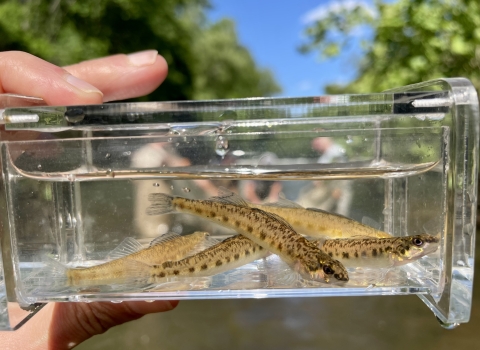In 2022, the U.S. Fish and Wildlife Service added nearly 6,000 acres of public land to the National Wildlife Refuge System in Texas. This brings the total number of Service-managed lands in the state to nearly 700,000 acres at 21 National Wildlife Refuges and three National Fish Hatcheries.
The acquisitions protect a variety of ecosystems across the state, including Columbia bottomlands habitat on the mid-Texas coast, freshwater wetlands on the upper Texas coast, bottomland hardwood and pine forest habitat in East Texas, and Tamaulipan thornscrub habitat in the Lower Rio Grande Valley.
“We are grateful for all of the partners who assisted us in acquiring and conserving these extraordinary properties for the benefit of wildlife and the American people,” said Amy Lueders, the Service’s Southwest Regional Director. “Each of these acquisitions protects a unique piece of the Texas landscape along with the resident and migratory wildlife that call it home. I encourage everyone to visit a National Wildlife Refuge to experience these wondrous places in person.”
At San Bernard National Wildlife Refuge on the mid-Texas coast, the Service acquired nearly 5,000 acres of Columbia Bottomlands habitat for the benefit of resident and migratory wildlife on two separate tracts of land. Columbia Bottomlands habitat is a critically important area for millions of migrating birds that use it as a staging area between wintering habitats in the Caribbean and South America and breeding habitats in North America. In addition to being a major migratory stopover and resting area for Nearctic-Neotropical migratory birds, Columbia Bottomlands habitat supports resident reptiles, amphibians and mammals like swamp rabbits, white-tailed deer, red-eared slider turtles, and wood ducks. The refuge is also a place for people to enjoy nature and the outdoors through wildlife watching, photography, hunting, fishing, and environmental education programs.
At McFaddin National Wildlife Refuge on the upper Texas Coast,the Service acquired a 415.50-acre portion of the Sabine Ranch. Located 75 miles east of Houston, the 12,376-acre Sabine Ranch is a critical component of the largest contiguous fresh and intermediate tidal marsh system in Texas. Multiple federal, state and private organizations have identified the Sabine Ranch as a high-value wintering waterfowl area. The coastal wetland and prairies also benefit many species of grassland and migratory birds, including mottled ducks and the threatened eastern black rail. The protection of the Sabine Ranch also helps provide a coastal buffer for hurricanes and storm surges.
At Neches River National Wildlife Refuge in East Texas, the Service acquired 249.18 acres of bottomland hardwood and pine forest habitat with 4 miles of Neches River frontage. The property contains a mixed pine forest along the higher elevations and bottomland hardwood forest along the Neches River riparian riparian
Definition of riparian habitat or riparian areas.
Learn more about riparian wetlands. The property is a major stopover and resting area for migratory, wintering and breeding populations of waterfowl including lesser scaup, mallard, mottled duck and wood duck. Neches River National Wildlife Refuge is also a place for people to enjoy nature and the outdoors through wildlife watching, photography, hunting, fishing, and environmental education programs.
At Laguna Atascosa National Wildlife Refuge in the Lower Rio Grande Valley, the Service acquired 40 acres adjacent to existing refuge lands in Cameron County. The northwest portion of the tract is part of an old resaca, or meander channel, and hosts native vegetation such as colima or lime prickly ash. Wildlife documented on or near the property include cardinal, horned lark, mockingbird, red-tailed hawk, Harris’ hawk, northern harrier and golden-fronted woodpecker, along with evidence of raccoon, coyote, and deer.
At Lower Rio Grande Valley National Wildlife Refuge in the Lower Rio Grande Valley, the Service acquired 19.71 acres of a former farm field along the natural floodplain of the Rio Grande. Native wildlife species that will benefit from this acquisition include Virgina opossums, eastern cottontails, coyotes, raccoons, striped skunks, bobcats, green jays, golden-fronted woodpeckers, doves, flycatchers, hawks, kestrels, and caracaras.
These acquisitions were made possible with the help of a number of non-profit conservation partners and private donors, including The Nature Conservancy, Knobloch Family Foundation, The Brown Foundation, the National Fish and Wildlife Foundation, The Bezos Earth Fund, The Conservation Fund, Friends of the Wildlife Corridor, and Friends of Laguna Atascosa National Wildlife Refuge. To purchase the acquisitions, the Service spent a total of $14,360,961 from the Land and Water Conservation Fund (LWCF) and Migratory Bird Conservation Fund (MBCF).
National wildlife refuges provide vital habitat for thousands of species and access to world-class recreation, from fishing, hunting, and paddling to nature watching, photography and environmental education. National wildlife refuges also contribute $3.2 billion per year into local economies and support more than 41,000 jobs, according to the Service’s report Banking on Nature.
These acquisitions support a main pillar of the Biden-Harris administration’s America the Beautiful initiative, contributing to the goal of conserving 30 percent of our lands and waters by 2030. The effort aims to support locally led and voluntary conservation and restoration efforts across public, private, and Tribal lands and waters in order to create jobs and strengthen the economy’s foundation; tackle the climate and nature crises; and address inequitable access to the outdoors.





